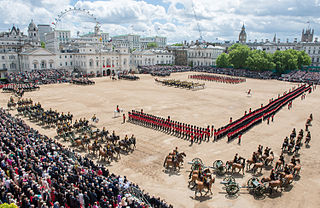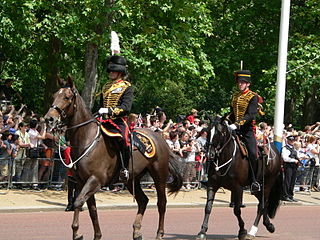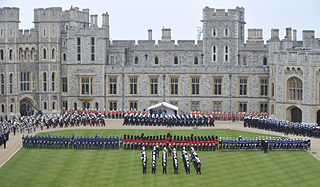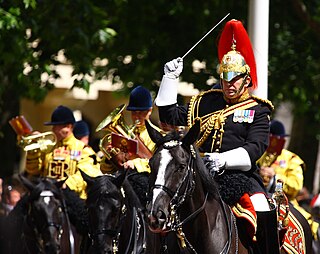| Year | Date | Colour | Salute taken by | Remarks |
|---|
| 1890 | Sat 31 May | 2nd Battalion, Coldstream Guards | The Prince of Wales | |
| 1891 | Sat 22 May | 3rd Battalion, Coldstream Guards | Queen Victoria | |
| 1892 | Sat 25 May | 2nd Battalion, Scots Guards | Queen Victoria | |
| 1893 | Sat 8 June | 1st Battalion, Coldstream Guards | Queen Victoria | |
| 1894 | Sat 26 May | 1st Battalion, Grenadier Guards | The Prince of Wales | |
| 1895 | Fri 24 May | 1st Battalion, Scots Guards | Queen Victoria | Held at Windsor Castle< [4] |
| 1895 | Sat 25 May | 2nd Battalion, Scots Guards | The Prince of Wales | Held at Horse Guards Parade |
| 1896 | Wed 20 May | 2nd Battalion, Grenadier Guards | The Prince of Wales | |
| 1897 | Mon 24 May | 2nd Battalion, Coldstream Guards | The Prince of Wales | |
| 1898 | Sat 21 May | 1st Battalion, Coldstream Guards | The Prince of Wales | |
| 1899 | Sat 3 June | 2nd Battalion, Coldstream Guards | The Prince of Wales | |
| 1900 | Wed 23 May | 1st Battalion, Grenadier Guards | The Prince of Wales | Royal Guards Reserve Regiment form one of the Guards [5] |
| 1901 | Fri 24 May | 1st Battalion, Scots Guards | King Edward VII | Colours presented to the 3rd Battalion, Scots Guards |
| 1902 | Fri 30 May | 1st Battalion, Irish Guards, | The King | Colours presented to the 1st Battalion, Irish Guards |
| 1903 | Fri 26 Jun | 2nd Battalion, Coldstream Guards | The King | |
| 1904 | Fri 26 Jun | 3rd Battalion, Coldstream Guards | The King | Short Magazine Lee–Enfield Mk I appears |
| 1905 | cancelled due to weather |
| 1906 | cancelled due to weather |
| 1907 | Fri 28 Jun | 1st Battalion, Irish Guards | The King | Short Magazine Lee–Enfield Mk III appears |
| 1908 | Sat 26 Jun | 1st Battalion, Coldstream Guards | The King | |
| 1909 | cancelled due to weather |
| 1910 | cancelled due to Court Mourning |
| 1911 | Sat 27 May | 2nd Battalion, Scots Guards | King George V | |
| 1912 | Fri 22 Jun | 1st Battalion, Coldstream Guards | The King | |
| 1913 | Fri 14 Jun | 2nd Battalion, Scots Guards | The King | |
| 1914 | Fri 26 Jun | 1st Battalion, Grenadier Guards | The King | |
| 1915-1918 | cancelled due to First World War |
| 1919 | Tue 3 June | 3rd Battalion, Coldstream Guards | The King | Held in Hyde Park; the largest ever parade with 11 Guards, all dressed in Service Dress, the Guards Machine Gun Regiment form one of the Guards |
| 1920 | Sat 5 June | 1st Battalion, Grenadier Guards | The King | Held in Hyde Park; dressed in Service Dress |
| 1921 | Sat 4 June | 1st Battalion, Grenadier Guards | The King | Held at Horse Guards Parade; Return to full dress |
| 1922 | Sat 3 June | 1st Battalion, Coldstream Guards | The King | |
| 1923 | Sat 4 June | 2nd Battalion, Scots Guards | The King | |
| 1924 | Tue 3 June | 2nd Battalion, Scots Guards | The King | |
| 1925 | Wed 3 June | 1st Battalion, Irish Guards | The King | |
| 1926 | cancelled due to General Strike |
| 1927 | Sat 4 June | 1st Battalion, Grenadier Guards | The King | |
| 1928 | Sat 3 June | 1st Battalion, Coldstream Guards | The King | |
| 1929 | Sat 4 June | 2nd Battalion, Scots Guards | The Duke of Connaught | The King was ill |
| 1930 | Tue 3 June | 2nd Battalion, Scots Guards | The Prince of Wales | The King was ill |
| 1931 | Sat 6 June | 2nd Battalion, Coldstream Guards | The King | |
| 1932 | Sat 4 June | 2nd Battalion, Grenadier Guards | The King | |
| 1933 | Sat 3 June | 3rd Battalion, Grenadier Guards | The King | |
| 1934 | Mon 4 June | 1st Battalion, Scots Guards | The King | |
| 1935 | Mon 3 June | 1st Battalion, Irish Guards | The King | |
| 1936 | Tue 23 June | 1st Battalion, Grenadier Guards | King Edward VIII | |
| 1937 | Wed 9 June | 1st Battalion, Coldstream Guards | King George VI | |
| 1938 | Thu 9 June | 2nd Battalion, Scots Guards | The King | |
| 1939 | Wed 3 June | 2nd Battalion, Coldstream Guards | The Duke of Gloucester | the King was in Canada and the USA, six Guards present. This would be the first Trooping the Colour to be televised live by the BBC Television Service. [6] |
| 1940-1946 | cancelled due to Second World War |
| 1947 | Thu 12 June | 2nd Battalion, Coldstream Guards | The King | All ranks wore Battle Dress, all officers on parade did not have swords, except the Regimental Sergeant Major; Rifle No 4 appears. Last parade when the King was mounted |
| 1948 | cancelled due to weather |
| 1949 | Thu 9 June | 1st Battalion, Welsh Guards | The King | Full dress uniform resumed. The King took the salute in the 1902 State Landau |
| 1950 | Thu 8 June | 3rd Battalion, Coldstream Guards | The King | George VI's last parade. Took the salute again in the 1902 State Landau |
| 1951 | Thu 7 June | 3rd Battalion, Grenadier Guards | The Princess Elizabeth | The King was ill, the princess wore her red full dress uniform for the first time and was mounted on Winston |
| 1952 | Thu 5 June | 2nd Battalion, Scots Guards | Queen Elizabeth II | |
| 1953 | Thu 11 June | 1st Battalion, Grenadier Guards | The Queen | Prince Philip present in Field Marshal's uniform |
| 1954 | Thu 10 June | 1st Battalion, Coldstream Guards | The Queen | Five Guards on parade |
| 1955 | cancelled due to national rail strike |
| 1956 | Wed 31 May | 3rd Battalion, Grenadier Guards | The Queen | Eight Guards resume |
| 1957 | Wed 13 June | 1st Battalion, Irish Guards | The Queen | the Queen mounted on Imperial |
| 1958 | Thu 12 June | 1st Battalion, Scots Guards | The Queen | |
| 1959 | Sat 13 June | 3rd Battalion, Coldstream Guards | The Queen | Start of regular Saturday parades; 3rd Battalion, Coldstream Guards placed in suspended animation, National Service ends. |
| 1960 | Sat 11 June | 3rd Battalion, Grenadier Guards | The Queen | L1A1 Self-Loading Rifle appears; 3rd Battalion, Grenadier Guards placed in suspended animation, number of Guardsmen in each Guard reduced from 76 to 70. |
| 1961 | Sat 10 June | 2nd Battalion, Scots Guards | The Queen | the Queen mounted on Imperial |
| 1962 | Sat 2 June | 2nd Battalion, Coldstream Guards | The Queen | 10th Trooping by the Queen |
| 1963 | Sat 8 June | 2nd Battalion, Grenadier Guards | The Queen | Seven Guards on parade; the queen mounted on a grey police horse named "Doctor" [7] |
| 1964 | Sat 13 June | 1st Battalion, Coldstream Guards | The Queen | the Queen mounted on Imperial |
| 1965 | Wed 12 June | 1st Battalion, Welsh Guards | The Queen | the Queen mounted on Imperial |
| 1966 | Sat 11 June | 1st Battalion, Irish Guards | The Queen | the Queen mounted on Doctor |
| 1967 | Sat 10 June | 1st Battalion, Grenadier Guards | The Queen | the Queen mounted on Doctor |
| 1968 | Sat 8 June | 2nd Battalion, Coldstream Guards | The Queen | Number of Guards laid down as eight, the Queen mounted on Neill |
| 1969 | Sat 14 June | 1st Battalion, Scots Guards | The Queen | The Queen rides Burmese for the first time |
| 1970 | Sat 13 June | 2nd Battalion, Scots Guards | The Queen | This was the first Trooping the Colour to be televised and aired live in colour on BBC One |
| 1971 | Sat 12 June | 2nd Battalion, Grenadier Guards | The Queen | |
| 1972 | Sat 3 June | 1st Battalion, Coldstream Guards | The Queen | 20th Trooping by the Queen |
| 1973 | Sat 2 June | 1st Battalion, Welsh Guards | The Queen | |
| 1974 | Sat 15 June | 1st Battalion, Irish Guards | The Queen | |
| 1975 | Sat 14 June | 1st Battalion, Grenadier Guards | The Queen | |
| 1976 | Sat 12 June | 2nd Battalion, Coldstream Guards | The Queen | |
| 1977 | Sat 11 June | 1st Battalion, Grenadier Guards | The Queen | 25th Trooping by the Queen |
| 1978 | Sat 3 June | 2nd Battalion, Grenadier Guards | The Queen | |
| 1979 | Sat 16 June | 2nd Battalion, Scots Guards | The Queen | |
| 1980 | Sat 14 June | 1st Battalion, Irish Guards | The Queen | |
| 1981 | Sat 13 June | 1st Battalion, Welsh Guards | The Queen | Blanks fired at the queen by Marcus Sarjeant [8] |
| 1982 | Sat 12 June | 1st Battalion, Coldstream Guards | The Queen | 30th Trooping by the Queen. Number of Guards reduced from eight to six due to the Falklands War |
| 1983 | Sat 11 June | 1st Battalion, Grenadier Guards | The Queen | Eight Guards resume |
| 1984 | Sat 16 June | 2nd Battalion, Grenadier Guards | The Queen | |
| 1985 | Sat 15 June | 2nd Battalion, Coldstream Guards | The Queen | |
| 1986 | Sat 14 June | 1st Battalion, Scots Guards | The Queen | Last parade when the Queen was mounted [9] |
| 1987 | Sat 13 June | 2nd Battalion, Scots Guards | The Queen | |
| 1988 | Sat 11 June | 1st Battalion, Irish Guards | The Queen | Rifle 5.56mm L85A1 appears |
| 1989 | Sat 17 June | 1st Battalion, Coldstream Guards | The Queen | |
| 1990 | Sat 16 June | 1st Battalion, Welsh Guards | The Queen | |
| 1991 | Sat 15 June | 2nd Battalion, Grenadier Guards | The Queen | |
| 1992 | Sat 13 June | 1st Battalion, Grenadier Guards | The Queen | 40th Trooping by the Queen. Last parade with eight Guards. Last appearance of the Princess of Wales in the official party. |
| 1993 | Sat 12 June | 2nd Battalion, Coldstream Guards | The Queen | Six Guards on parade; 2nd Battalion, Coldstream Guards and 2nd Battalion, Scots Guards placed in suspended animation |
| 1994 | Sat 11 June | 2nd Battalion, Grenadier Guards | The Queen | 2nd Battalion, Grenadier Guards placed in suspended animation; represented by Nijmegen Company |
| 1995 | Sat 17 June | 1st Battalion, Scots Guards | The Queen | |
| 1996 | Sat 15 June | 1st Battalion, Irish Guards | The Queen | |
| 1997 | Sat 14 June | 2nd Battalion, Scots Guards | The Queen | 2nd Bn represented by F Company; first appearance of the King's Troop, Royal Horse Artillery |
| 1998 | Sat 13 June | 1st Battalion, Welsh Guards | The Queen | |
| 1999 | Sat 12 June | 1st Battalion, Coldstream Guards | The Queen | |
| 2000 | Sat 17 June | 2nd Battalion, Coldstream Guards | The Queen | 2nd Bn represented by No. 7 Company |
| 2001 | Sat 16 June | 2nd Battalion, Grenadier Guards | The Queen | 2nd Bn represented by Nijmegen Company |
| 2002 | Sat 15 June | 1st Battalion, Scots Guards | The Queen | 50th Trooping by the Queen |
| 2003 | Sat 14 June | 1st Battalion, Grenadier Guards | The Queen | |
| 2004 | Sat 12 June | 1st Battalion, Grenadier Guards | The Queen | |
| 2005 | Sat 11 June | 1st Battalion, Irish Guards | The Queen | First appearance of the Duchess of Cornwall in the official party |
| 2006 | Sat 17 June | 1st Battalion, Welsh Guards | The Queen | |
| 2007 | Sat 16 June | 2nd Battalion, Coldstream Guards | The Queen | 2nd Bn represented by No. 7 Company |
| 2008 | Sat 14 June | 1st Battalion, Welsh Guards | The Queen | |
| 2009 | Sat 13 June | 1st Battalion, Irish Guards | The Queen | Seven guards |
| 2010 | Sat 12 June | 1st Battalion, Grenadier Guards | The Queen | |
| 2011 | Sat 11 June | 1st Battalion, Scots Guards | The Queen | Prince William rides in escort behind the Queen's carriage. The Duchess of Cambridge rides in procession for the first time. |
| 2012 | Sat 16 June | 1st Battalion, Coldstream Guards | The Queen | 60th Trooping by the Queen |
| 2013 | Sat 15 June | 1st Battalion, Welsh Guards | The Queen | Prince Philip not in attendance due to ill health. The Duke of Kent took his place beside the Queen. |
| 2014 | Sat 14 June | 2nd Battalion, Grenadier Guards | The Queen | 2nd Bn represented by Nijmegen Company [10] |
| 2015 | Sat 13 June | 1st Battalion, Welsh Guards | The Queen | |
| 2016 | Sat 11 June | 2nd Battalion, Coldstream Guards | The Queen | 2nd Bn represented by No. 7 Company [11] |
| 2017 | Sat 17 June | 1st Battalion, Irish Guards | The Queen | 65th Trooping by the Queen. Prince Philip and the Duke of Kent not in uniform |
| 2018 | Sat 9 June | 1st Battalion, Coldstream Guards | The Queen | Prince Philip not in attendance, the Duke of Kent flanked HM the Queen at the saluting base. First appearance of the Duchess of Sussex in the official party. First time bagpipes are played during the march past on the troop when neither the Scots or Irish are trooping. First time Duke of York is present as the Colonel of the Grenadier Guards. |
|
| 2019 | Sat 8 June | 1st Battalion, Grenadier Guards | The Queen | Prince Philip not in attendance, Rifle 5.56mm L85A3 appears [12] |
| 2020 | Sat 13 June | 1st Battalion, Welsh Guards | The Queen | Short parade at Windsor Castle as a result of 2020 COVID-19 pandemic [13] It was configured to comply with social distancing standards. [14] The Welsh Guards later went on to take part in the changing of the guard ceremony later that day. |
|

















